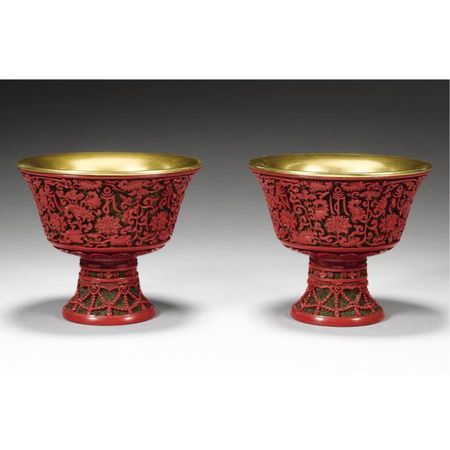An Exceptional Pair Of Imperial Cinnabar Lacquer Stem Bowls. Qianlong Seal Marks And Period
An Exceptional Pair Of Imperial Cinnabar Lacquer Stem Bowls. Qianlong Seal Marks And Period
each body with deep slightly rounded sides rising from a tall hollow spreading foot to a flaring rim, finely and deeply carved around the exterior through the red lacquer layers to a black ground with eight lanca characters amidst leafy lotus strapwork panels above a lotus-lappet band, the stem with narrow floret bands above a ruyi band hung with pendent jewels, all reserved on a floret-diaper ground, the interior of the stem lacquered red and painted in gilt with the six-character mark, the interior with a gilt-bronze liner. 12.8cm., 5in. Estimate 300,000—500,000 GBP
NOTE: The exceptional skills of lacquer carvers working in the Lacquer Workshop of the Zaobanchu (Imperial Palace Workshops) in the Forbidden City is displayed in this pair of magnificent and rare Qianlong period stemcups. The cups are impressive for their size and for their deep and intricate carving. The design is rendered with great precision to the minutest detail. The lacquer itself is thick and shows a number of layers which are characteristic traits of the finest quality lacquer of this period.
Only five other stemcups of this form and design are known; one in the Asian Art Museum of San Francisco illustrated in Hai-wai yi-chen. Lacquerware, Taipei, 1987, pl. 153; one from the Qing Court collection and still in Beijing published in Carved Lacquer in the Palace Museum, Beijing, 1985, pl. 338; one in the Linden Museum, Stuttgard, included in the exhibition Im Zeichen des Drachen, Museum fur Lackkunst, Munster, 2006, cat. no. 86; a fourth in the Shandong Tai'an City Museum, Tai'an, illustrated in Zhongguo qiqi quanji, vol. 6, Fujian, 1993, pl. 212; and an unmarked stemcup sold at Christie's London, 23rd June 1980, lot 146, from the collection of Heliot Fils, Paris.
Lacquer wares of the Qianlong reign often echoed in style that of the underglaze-blue decorated porcelains, characterized by deep and naturalistic carving and velvety smoothness to the finish. Lacquer is inherently an application on to other materials such as wood, clay or metal. Shapes and designs therefore often echoed the effects of contemporaneous porcelain and indeed the present pair of stembowls is after Qianlong mark and period blue-and-white vessels of the same form, size and painted decoration. For example see a Qianlong blue-and-white stembowl, from the Ohlmer collection in the Roemer Museum, Hildesheim, illustrated in Ulrich Wiesner, Chinesisches Porzellan, Mainz am Rhein, 1981, pl. 59, together with a slightly later, Jiaqing period example, pl. 60. Another similar but slightly smaller blue-and-white stemcup is published in the Catalogue of Ch'ing Dynasty Porcelain in the National Palace Museum, Tokyo, 1981, pl. 13.
The decoration of a frieze of Tibetan lanca characters enclosed by lotus scrolls with the interlaced tasselled band around the stem was highly favoured by the Qianlong emperor who was a keen follower of Tibetan Buddhism and saw himself as the incarnation of the Bodhisattva Manjushri. Qianlong was a genuine practitioner of Buddhism and showed great reverence towards Buddhist ceremonies. He commissioned a large number of ritual and ceremonial implements to be made in the Palace Workshops for the many Tibetan temples in the Forbidden City as well as for gifts to the Tibetan religious hierarchy. During his reign, Palace Workshops manufacturing these implements were supervised by two high lamas, Zhangjia Rimpoche and Anwangjiu Zhu'er. It is known that the emperor inspected every piece to ensure that the canonical prescriptions for the making of the objects were strictly followed.
The form of these stembowls is inspired by Tibetan butter lamps (su you deng) that were placed in front of Buddhist shrines in the temples. These lamps were lit all year around and are called a butter lamp after the fuel it uses. See a pure gold butter lamp, from the Potala Palace collection, included in the exhibition Treasures from the Snow Mountains. Gems of Tibetan Cultural Relics, Shanghai Museum, Shanghai, 2001, cat.no. 68.
For examples of altar wares carved in lacquer see a garniture comprising of two candle-holders, two vases and an incense burner, all bearing six-character Qianlong reign marks, from the Qing court collection and still in Beijing, illustrated in The Complete Collection of Treasures of the Palace Museum. Lacquer Wares of the Qing Dynasty, Hong Kong, 2006, pl. 25; and a set of two candle-holders and a censer, also with a Qianlong reign mark and of the period, sold at Christie's London, 5/6th July 1983, lot 33.
Fine Chinese Ceramics and Works of Art. 05 Nov 08. London. Photo courtesy Sotheby's. www.sothebys.com

/https%3A%2F%2Fprofilepics.canalblog.com%2Fprofilepics%2F1%2F0%2F100183.jpg)
/https%3A%2F%2Fstorage.canalblog.com%2F03%2F02%2F119589%2F96711876_o.jpg)
/https%3A%2F%2Fstorage.canalblog.com%2F11%2F31%2F119589%2F94773502_o.jpg)
/https%3A%2F%2Fstorage.canalblog.com%2F20%2F83%2F119589%2F94772815_o.jpg)
/https%3A%2F%2Fstorage.canalblog.com%2F26%2F72%2F119589%2F75604929_o.jpg)
/https%3A%2F%2Fstorage.canalblog.com%2F59%2F60%2F119589%2F26458628_o.jpg)



/http%3A%2F%2Fstorage.canalblog.com%2F44%2F50%2F119589%2F112386483_o.jpg)
/http%3A%2F%2Fstorage.canalblog.com%2F64%2F84%2F119589%2F96008206_o.jpg)
/http%3A%2F%2Fstorage.canalblog.com%2F60%2F67%2F119589%2F95668500_o.jpg)
/http%3A%2F%2Fstorage.canalblog.com%2F71%2F41%2F119589%2F75520898_o.jpg)